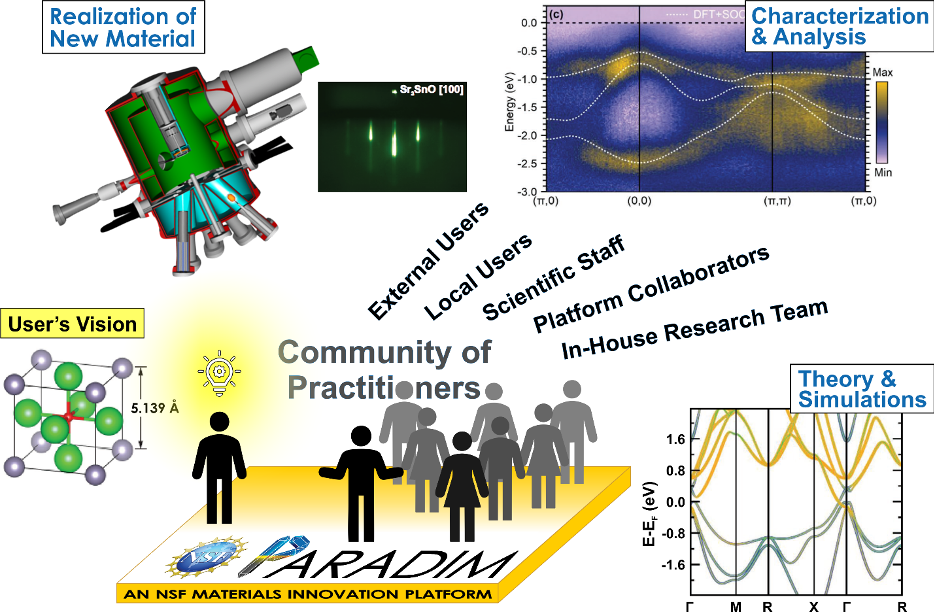An enlightened and seasoned scientist had a bold vision—to make a new type of topological insulator in a form that could be relevant to technology. The dream compound involved a material predicted to have the desired band structure, but it had never been realized. The group tried for two years to make a simpler version of the material in their own lab, but could not find the right conditions. The group came to PARADIM and in two visits totaling six weeks of round-the-clock molecular-beamtime, they succeeded!
Guided by thermodynamic calculations from Platform collaborators at Penn State, a growth protocol was designed and implemented on PARADIM’s signature tool that enabled exquisite control of the sample growth. All relevant measurements were made without exposing the sample to air to assess and optimize its crystalline perfection and electronic structure. The bandstructure of the new material was measured and compared to calculated expectations provided by PARADIM’s Theory & Simulation Facility. This new type of topological insulator should be more readily tuned by the underlying substrate and layering to provide desired and technologically useful properties than traditional topological insulators.
What Has Been Achieved: Topological materials are derived from the interplay between symmetry and topology. Advances in topological band theories have led to the prediction that the antiperovskite oxide Sr3SnO is a topological crystalline insulator, a new electronic phase of matter where the conductivity in its (001) crystallographic planes is protected by crystallographic point group symmetries. Realization of this material, however, is challenging. Guided by thermodynamic calculations, a deposition approach is designed and implemented to achieve the adsorption-controlled growth of epitaxial Sr3SnO single-crystal films by molecular-beam epitaxy (MBE). In situ transport and angle-resolved photoemission spectroscopy measurements reveal the metallic and electronic structure of the as-grown samples. Compared with conventional MBE, the “suboxide MBE” synthesis route used results in superior sample quality and is readily adapted to other topological systems with antiperovskite structures.
Importance of the Achievement: This synthesis approach leads to films of exceptional quality enabling the intrinsic non-trivial topology of the correlated electrons in Sr3SnO by ARPES to be established. The fabrication process can be adapted to produce other A3BO-based topological crystalline insulator materials, which will significantly expand the materials space for topological crystalline insulator research and foster the engineering of topological electronics.
Unique Feature(s) of the MIP that Enabled this Achievement: Realizing this challenging material was made possible by PARADIM’s community of practitioners pulling together to collaboratively identify a synthesis path and making use of a signature tool that combines MBE, ARPES, XPS, LEED, R vs. T and electronic property calculations. This material is unstable in air, so the extensive in situ measurements possible in PARADIM were essential in creating this material and comparing its optimized properties with theoretical predictions.
The work was conceived and performed by PARADIM users from the University of Wisconsin-Madison and with contributions from Penn State University, supported by PARADIM staff scientists and members of PARADIM’s In-House Research Team.
Full Reference: Y. Ma, A. Edgeton, H. Paik, B. Faeth, C. Parzyck, B. Pamuk, S.-L. Shang, Z.-K. Liu, K.M. Shen, D.G. Schlom, and C.-B. Eom, “Realization of Epitaxial Thin Films of the Topological Crystalline Insulator Sr3SnO,” Adv. Mater. 32, 2000809 (2020).
Data Reference: Experimental raw data are available at https://data.paradim.org/113.








